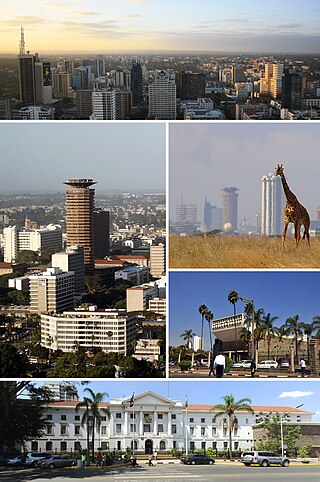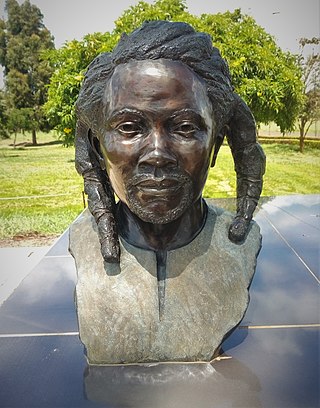Related Research Articles

Nairobi is the capital and largest city of Kenya. The name is derived from the Maasai phrase Enkare Nairobi, which translates to 'place of cool waters', a reference to the Nairobi River which flows through the city. The city proper had a population of 4,397,073 in the 2019 census. The Greater Nairobi Metropolitan Area has a population of about 7,000,000 people. The city is commonly referred to as The Green City in the Sun.

The Mau Mau rebellion (1952–1960), also known as the Mau Mau uprising, Mau Mau revolt, or Kenya Emergency, was a war in the British Kenya Colony (1920–1963) between the Kenya Land and Freedom Army (KLFA), also known as the Mau Mau, and the British authorities. Dominated by Kikuyu, Meru and Embu fighters, the KLFA also comprised units of Kamba and Maasai who fought against the European colonists in Kenya, the British Army, and the local Kenya Regiment.
Limuru is a town in central Kenya. It is also the name of a parliamentary constituency and an administrative division. The population of the town, as of 2004, was about 4,800. In a census taken in 2019 the population had increased to 159,314.

Dedan Kimathi Waciuri was the senior military and spiritual leader of the Kikuyu rebels involved in the Mau Mau Uprising. Widely regarded as a revolutionary leader, he led the armed military struggle against the British colonial regime in Kenya in the 1950s until his capture in 1956 and execution in 1957. Kimathi is credited with leading efforts to create formal military structures within the Mau Mau, and convening a war council in 1953. He, along with Baimungi M'marete, Musa Mwariama, General China and Muthoni Kirima, was one of the Field Marshals.

Nyeri is a town situated in the Central Highlands of Kenya. It is the county headquarters of Nyeri County. The town was the central administrative headquarters of the country's former Central Province. Following the dissolution of the former provinces by Kenya's new constitution on 26 August 2010, the city is situated about 150 km north of Kenya's capital Nairobi, in the country's densely populated and fertile Central Highlands, lying between the eastern base of the Aberdare (Nyandarua) Range, which forms part of the eastern end of the Great Rift Valley, and the western slopes of Mount Kenya.
The Green Belt Movement (GBM) is an indigenous grassroots organization in Kenya that empowers women through the planting of trees. It is one of the most effective and well-known grassroots organisations addressing the problem of global deforestation. Professor Wangari Maathai established the organization in 1977 under the auspices of the National Council of Women of Kenya (NCWK). GBM's successes in forest conservation, education, and women's economic empowerment have gained the organisation worldwide acclaim. It is also noted for its advocacy of human rights, democratisation of access to public lands, and environmental justice issues such as the role of women's traditional ecological knowledge in addressing environmental degradation and desertification.

The Ngong Hills are peaks in a ridge along the Great Rift Valley, located southwest near Nairobi, in southern Kenya. The word "Ngong" is an Anglicization of a Maasai phrase "enkong'u emuny" meaning rhinoceros spring, and this name derives from a spring located near Ngong Town.
Karen is a suburb of Nairobi in Kenya, lying south-west of Nairobi's central business district. The suburb of Karen borders the Ngong Forest and is home to the Ngong Racecourse. Karen and Langata previously formed a somewhat isolated area of mid to high-income residents, but the two suburbs have become increasingly interconnected and linked to the rest of Nairobi through the expansion of the eponymous Langata Road and Ngong Road, the latter project completed in 2021.
Lang'ata is a predominantly middle-class residential suburb of Nairobi in Kenya. The suburb consists of many smaller housing developments, referred to as estates. They include Nairobi Dam, Otiende, Southlands, Ngei, Jambo estate, Onyonka, Madaraka Estate, Kutch Prant, Rubia, NHC Langata, Akiba, Sun Valley, Royal Park and many others. These developments are primarily maisonettes or apartment blocks.

Environmental issues in Kenya include deforestation, soil erosion, desertification, water shortage and degraded water quality, flooding, poaching, and domestic and industrial pollution.

Starehe Boys' Centre and School is a partial-board, boys-only school in Nairobi, Kenya. The school was founded in 1959 by Dr. Geoffrey William Griffin, MBS, OBE, Geoffrey Gatama Geturo and Joseph Kamiru Gikubu. It started as a rescue centre in Nairobi. The school is a member of the Round Square network of schools.

The Nairobi School is a secondary school in Nairobi, Kenya. It follows the national curriculum, is one of Kenya's 112 national schools and also one of the 18 prestigious Cluster III secondary schools.

Westlands is a mixed-use neighbourhood in Upper Parklands in Nairobi. Located 3.0 kilometres (2 mi) from Nairobi's central business district, it sits on the westerly areas of the larger Parklands area of Nairobi.
Molo is a town in Nakuru County. It is also one of the 11 constituencies in Nakuru County and is served by a branch of Kenya Railways, formerly the Uganda Railway, East African Railways Corporation until 1977. Molo hosts a town council. The town has a population of 156,732.
Kilimani is a mixed-use commercial and residential neighbourhood in the city of Nairobi.
The Kapenguria Six – Bildad Kaggia, Kung'u Karumba, Jomo Kenyatta, Fred Kubai, Paul Ngei, and Achieng' Oneko – were six leading Kenyan nationalists who were arrested in 1952, tried at Kapenguria in 1952–53, and imprisoned thereafter in Northern Kenya.

Karura Forest is an urban forest in Nairobi, the capital of Kenya. The forest was gazetted in 1932 and is managed by the Kenya Forest Service in conjunction with the Friends of Karura Forest Community Forest Association.
Ol Arabel is a river in the Great Rift Valley of Kenya that feeds Lake Baringo. It gives its name to a forest covering its headwaters and to a region.
Operation Anvil was a British military operation during the Mau Mau Uprising where British troops attempted to remove suspected Mau Mau from Nairobi and place them in Langata Camp or reserves. The operation began on 24 April 1954 and took two weeks, at the end of which 20,000 Mau Mau suspects had been taken to Langata, and 30,000 more had been deported to the reserves.

During the colonial occupation of Kenya, Black Africans working on farms owned by white settlers were called "squatters" by the British. As of 1945, there were over 200,000 such squatters in the Highlands and more than half were Kikuyu. The Mau Mau rebellion began amongst these squatters in the late 1940s and after independence in the early 1960s, peasants started squatting land in rural areas without the permission of the owner.
References
- 1 2 Mutu, Kari (2021-09-08). "Taking a breather in Oloolua Forest green". The East African . Retrieved 2024-04-02.
- 1 2 3 4 "The Oloolua Forest". The Oloolua Forest. Retrieved 2024-04-02.
- ↑ Koech, Gilbert. "Alarm raised over illegal activities in Oloolua forest". The Star . Retrieved 2024-04-02.
- ↑ Mutanu, Bernardine (2020-06-29). "Managers of Oloolua Forest in Kajiado face the sack". Nation . Retrieved 2024-04-02.
- ↑ "KFS denies Oloolua forest land grabbing claims". Capital News. 2024-03-30. Retrieved 2024-04-02.